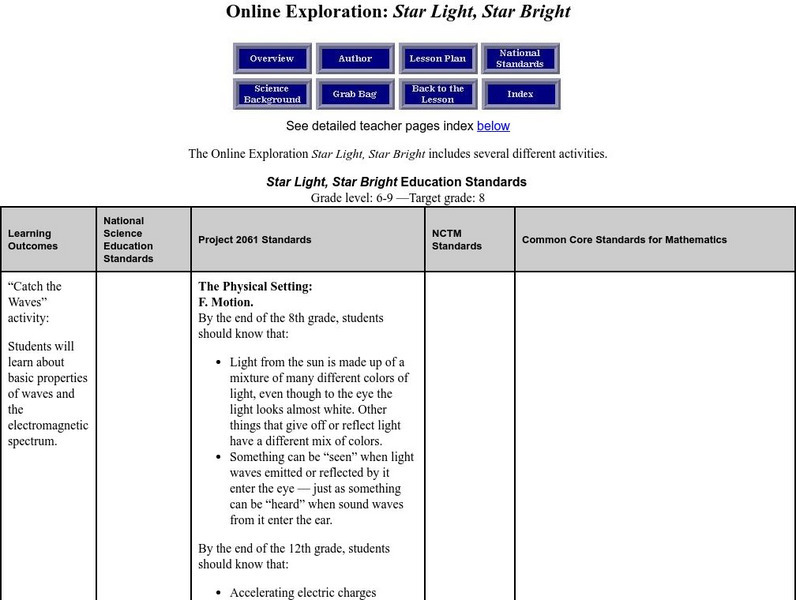Lawrence Berkeley National Laboratory
Berkeley Lab: University of California: Electromagnetic Radiation
This page defines electromagnetic radiation. Included are links to more information.
Other
Simple Science: Hurricane Central
Learners investigate images of Hurricane Katrina as it moved through the Gulf of Mexico in August 2005. The resource has students examine images, infrared radiation, water vapor, and visible radiation to plot and measure the path of...
Space Telescope Science Institute
Amazing Space: Star Light, Star Bright
This online exploration provides an opportunity to identify the different properties of waves and the relationship that exists between energy, wavelength, and frequency. Correlate images from the Hubble Telescope to the wavelength,...
Kansas State
The Laser Adventure
Kansas State University site explaining all aspects of LASERS. The site is set up as an online book with clickable chapters.
Georgia State University
Georgia State University: Hyper Physics: Temperature Regulation of the Human Body
Discusses the methods the human body uses to regulate body temperature. Includes links to the four external heat transfer mechanisms (radiation, conduction, convection, and evaporation of perspiration).
University Corporation for Atmospheric Research
Ucar: Solar Flare
Solar flares are huge explosions on the Sun that emit lots of electromagnetic radiation.
Georgia State University
Georgia State University: Hyper Physics: Geiger Counter
Contains some pictures and a brief description of how a Geiger Counter functions.
California Institute of Technology
Ipac: Iras Gallery
This site from IPAC is a series of images of various celestial objects and regions as viewed in infrared light. Each photo is accompanied by a caption.
Other
Newport: Introduction to Solar Radiation
Radiation from the sun sustains life on earth and determines climate. The energy flow within the sun results in a surface temperature of around 5800 K, so the spectrum of the radiation from the sun is similar to that of a 5800 K...
Sophia Learning
Sophia: Isotopes: Lesson 5
This lesson will introduce isotopes, and explain how they differ from other elements. It will also show that some isotopes are unstable and emit particles and/or radiation. It is 5 of 9 in the series titled "Isotopes."
Other
Simple Science: Snow and Ice Ii
The innovative resource compares snow and ice cover in the Northern Hemisphere over a period of 24 years. The images are obtained from satellite measurements of visible and microwave radiation. The activity has an interactive online...
CK-12 Foundation
Ck 12: Physical Science: Gamma Decay
[Free Registration/Login may be required to access all resource tools.] Explains how and why gamma decay occurs, what gamma rays are, and why gamma radiation is the most harmful.
US Environmental Protection Agency
Epa: Envirofacts Data Warehouse
Using zip codes, this site allows students to locate businesses in their communities that are producing wastes.
University of Colorado
University of Colorado: Ph Et Interactive Simulations: Alpha Decay
Watch alpha particles escape from a polonium nucleus, causing radioactive alpha decay. See how random decay times relate to the half life. Java required.
PBS
Pbs Teachers: Cancer Warrior: How Cancer Grows
Follow the progression of a malignant tumor, beginning with the first mutation within a cell and ending with metastasis, the colonization of related tumors throughout the body.
NOAA
Noaa: Space Environment Topics: Radio Wave Propagation [Pdf]
NOAA has produced a series of topic papers for use by teachers and students. This paper is on the increase of radio wave activity and the effects solar emissions have on it. PDF format.
NASA
Nasa: Tour of the Electromagnetic Spectrum: Visible Light
Visible light waves are the only electromagnetic waves we can see. We see these waves as the colors of the rainbow. Each color has a different wavelength. Red has the longest wavelength and violet has the shortest wavelength. When all...
NASA
Nasa: The Geiger Counter
Site from NASA explaining the construction and use of a Geiger counter. The site has links to many related topics, such as plasma, ions, and electrons.
Science4Fun
Science4 Fun: Lasers
What is a laser? Illustrated discussion of lasers includes how they work and how they are used.
NASA
Electromagnetic Spectrum: Ultraviolet Waves
Ultraviolet (UV) light has shorter wavelengths than visible light. Though these waves are invisible to the human eye, some insects can see them. The specific wavelength values are given. Uses and applications of these waves are explained.
Science4Fun
Science4 Fun: Heat
What is heat? Illustrated discussion of how heat is transferred and its effect on the states of matter.
Other
World Nuclear Association: Hiroshima, Nagasaki, and Subsequent Weapons Testing
This article has information about the bombings of Hiroshima and Nagasaki. Additional information about the measures that have been taken about atomic warfare and testing since the bombings included.
















